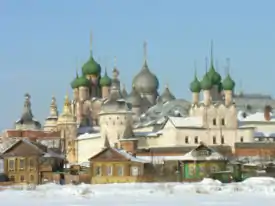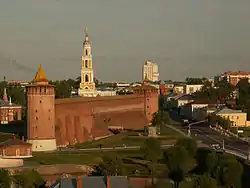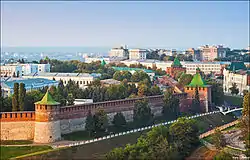Kremlin (fortification)
A kremlin or kreml (Russian: кремль, ˈkrʲemlʲ, "castle", or "citadel"[1]) is a major fortified central complex found in historic Russian cities.[2] This word is often used to refer to the most famous, the Moscow Kremlin,[3] or metonymically to the government that is based there.[4] The word is of Russian origin which itself might originate from Tatar language.[5][6][7][8] The word may share the same root as kremen (Russian: кремень, krʲɪˈmʲenʲ, "flint").[9] Some kremlins in Russia are called detinets, as for example the Novgorod Detinets.
Selected Russian cities with kremlins
World Heritage Sites
Intact
- Astrakhan Kremlin
- Kolomna Kremlin
- Nizhny Novgorod Kremlin
- Pskov Kremlin
- Rostov Veliky Kremlin (a bishop's residence, not formally considered a kremlin)

- Smolensk Kremlin
 A wall of Smolensk Kremlin in 1912
A wall of Smolensk Kremlin in 1912 Remains of the Kolomna Kremlin
Remains of the Kolomna Kremlin - Tobolsk Kremlin (the sole stone kremlin in Siberia)
- Tula Kremlin
- Zaraysk Kremlin
- Ivangorod Fortress (not formally considered a kremlin)
- Oreshek Fortress (not formally considered a kremlin)
- Staraya Ladoga
- Alexandrov Kremlin (a czar residence, not formally considered a kremlin)
- Korela Fortress (not formally considered a kremlin)
- Izborsk Kremlin
In ruins
- Gdov Kremlin
- Porkhov Kremlin
- Serpukhov Kremlin
- Velikie Luki Kremlin
- Torzhok Kremlin
- Mozhaysk Kremlin
- Fortress of Koporye (not formally considered a kremlin)
- Vyazma Kremlin (one tower)
- Syzran Kremlin (one tower, 1683)
- Ufa
Existing and unwalled
- Vladimir Kremlin (Tower Golden Gate and bank)
- Dmitrov
- Ryazan
- Vologda (a bishop residence, not formally considered a kremlin)
- Yaroslavl (two towers)
- Pereslavl-Zalessky
- Khlynov (Vyatka)
- Volokolamsk
Traces remain
- Borovsk
- Opochka
- Zvenigorod
- Starodub
- Tver – a wooden fortress was burned down in a fire in 1763
- Sknyatino – underwater since flooding during the 1930s.
- Yam fortress (not formally considered a kremlin)
- Fortress of Radonezh
- Ryazan
- Old Ryazan (60 km from modern Ryazan)
- Ostrov (14th-15th centuries)
- Belgorod (bank of fortress)
- Vereya
- Kaluga
- Kleshchin
- Kostroma
- Pustozyorsk
- Uglich
- Staritsa
- Sviyazhsk
- Cheboksary
- Yuryev-Polsky
- Aleksin
- Opochka
- Oryol
- Rurikovo gorodishche
- Mtsensk
- Raskiel
Modern imitations
- Izmaylovo Kremlin
- Yoshkar Ola
Kremlins outside the Russian Federation
After the disintegrations of the Kievan Rus, the Russian Empire and the USSR, some fortresses considered Kremlin-type, remained beyond the borders of modern Russia. Some are listed below:
- Belz, Ukraine (only traces)
- Kyiv, Ukraine (reconstructed tower of the Golden Gate)
- Putyvl, Ukraine
- Novhorod-Siverskyi, Ukraine
- Chernihiv, Ukraine (only traces)
- Kamyanyets, Belarus (shafts and Belaya Vezha tower)
- Belgorod Kievsky, Ukraine (now village Belgorodka)
The same structure in Ukraine is called dytynets (Ukrainian: дитинець, from dytyna – child). The term has been in use since the 11th century. The term kremlin first appeared in 14th century in Russian territories, where it replaced dytynets.
Many Russian monasteries have been built in a fortress-like style similar to that of a kremlin. For a partial list, see Monasteries in Russia.
See also
References
- Pleshakov, Constantine (2006). Stalin's Folly: The Tragic First Ten Days of World War II on the Eastern Front. Houghton Mifflin Harcourt. p. 24. ISBN 0618773614.
- G, Frank, Ben (2010-09-23). A Travel Guide to Jewish Russia & Ukraine. Pelican Publishing. p. 150. ISBN 9781455613281.
- Shubin, Daniel H. (2004). A History of Russian Christianity, Vol. I: From the Earliest Years through Tsar Ivan IV. Algora Publishing. p. 5. ISBN 9780875862873.
- Barcelona, Antonio; Benczes, Réka; Ibáñez, Francisco José Ruiz de Mendoza (2011). Defining Metonymy in Cognitive Linguistics: Towards a Consensus View. John Benjamins Publishing. p. 234. ISBN 978-9027223821.
- "Кром — Кремник — Кремль - Архитектура - РУССКОЕ ВОСКРЕСЕНИЕ". www.voskres.ru. Retrieved 2018-09-25.
- "kremlin | Origin and meaning of kremlin by Online Etymology Dictionary". www.etymonline.com. Retrieved 2018-09-26.
- "The Russian Kremlins". Free Tour Saint Petersburg. 2016-01-13. Retrieved 2018-09-26.
- Thompson, Della, ed. (2009). Oxford essential Russian dictionary : Russian-English, English-Russian. Oxford: Oxford University Press. p. 89. ISBN 9780199576432. OCLC 502676920.
- Russian Etymological Dictionary by Max Vasmer
Further reading
- Воронин Н. Н. Владимир, Боголюбово, Суздаль, Юрьев-Польской. М.: Искусство, 1967.
- Кирьянов И. А. Старинные крепости Нижегородского Поволжья. Горький: Горьк. книжн. изд., 1961.
- Косточкин В. В. Русское оборонное зодчество конца XIII — начала XVI веков. М.: Издательство Академии наук, 1962.
- Крадин Н. П. Русское деревянное оборонное зодчество". М.: Искусство, 1988.
- Раппопорт П. А. Древние русские крепости. М.: Наука, 1965.
- Раппопорт П. А. Зодчество Древней Руси. Л.: Наука, 1986.
- Раппопорт П. А. Строительное производство Древней Руси (X—XIII вв.). СПб: Наука, СПб, 1994.
- Сурмина И. О. Самые знаменитые крепости России. М.: Вече, 2002.
- Тихомиров М. Н. Древнерусские города. М.: Гос. изд. полит. лит-ры, 1956.
- Яковлев В. В. Эволюция долговременной фортификации. М.: Воениздат, 1931.
External links
| Wikimedia Commons has media related to Kreml. |
 Media related to Fortresses in Russia at Wikimedia Commons
Media related to Fortresses in Russia at Wikimedia Commons- Russian Fortification Architecture
- Twelve Russian Kremlins
- Cynthia Marsh. "Kremlin". Words of the World. Brady Haran (University of Nottingham).
